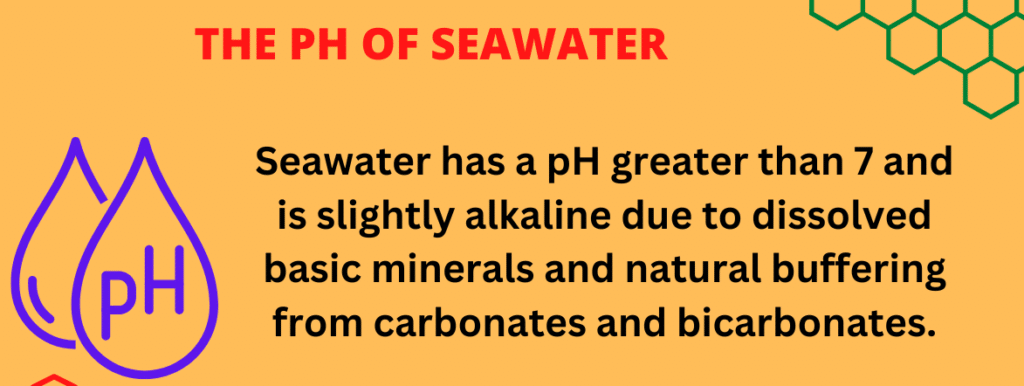Seawater has a pH greater than 7 and is slightly alkaline due to dissolved basic minerals and natural buffering from carbonates and bicarbonates.
Only 3% of the water on Earth is freshwater, while 97% is saline water. The composition of seawater is 96.5% water, 2.5% salts, and 1% other dissolved substances. Seawater contains large amounts of magnesium, bromine, and sodium chloride.

Table of Contents
What is pH in simple words?
In a chemistry lab, the pH scale is used to determine how acidic or basic something is. The scale ranges from 0 to 14, with 7 representing neutral, as in plain water. Anything with a pH less than 7 is considered acidic, while anything with a pH greater than 7 is considered alkaline. The presence of positively charged hydrogen ions (H+) in a solution makes it more acidic, while the presence of negatively charged hydroxide ions (OH-) makes it more basic.
The average pH of the ocean’s surface water is 8.1. Ocean water is more basic than drinking water because it resists pH changes due to the presence of other weak acids and their associated bases known as buffers. According to the pH scale, the ocean is slightly alkaline.
The pH of distilled water
Ideally, distilled water should have a pH of 7, making it neither acidic nor alkaline.
However, Due to its high purity, distilled water is extremely environmentally sensitive, and even a trace amount of carbon dioxide from the air can cause it to become slightly acidic. Water that has been deionized or distilled lacks a strong ionic presence. Because there aren’t enough ions in the solution for the pH electrode to function properly, measuring the pH of distilled water can be difficult.
As a result, distilled water’s pH is not always accurate. One solution could be a few drops of potassium chloride (KCL) added to the solution. Because KCL is an ionic compound containing K+ and Cl-ions, it is more conducive in water.
The addition of KCL to the distilled water has no effect on the reading, but it makes it more stable and thus more likely to produce reliable results.
Main components of Seawater
The following are the main components of seawater. By weight, these ions make up about 99 per cent of all sea salts.
- Chloride (Cl−)
- Sodium (Na+)
- Sulfate (SO24−)
- Magnesium (Mg2+)
- Calcium (Ca2+)
- Potassium (K+)
Why is sea water alkaline?
Seawater is high in salt content. Because of the dissolved basic minerals and the buffering mechanism of carbonate and bicarbonate ions, it is alkaline. Freshwater has a lower pH than seawater. The water in the ocean is salty, but the water in rivers and lakes is not.
Why Is Salt Water Dangerous to Drink?
Ocean water contains three to four per cent sodium. Human kidneys absorb sodium and expel it in urine, which is essential for maintaining proper sodium levels in the bloodstream. This process of flushing excess sodium from your body requires water. Since seawater contains so much sodium, your kidneys require more water to properly process the salt water you drink. This creates a vicious cycle in which the more salt water you drink, the more dehydrated your body becomes. Please check another related and interesting link ” What is fresh water?“.
More Links
- BCl3 Lewis Structure in four simple steps - November 1, 2023
- PH3 Lewis Structure in four simple steps - October 8, 2023
- PF3 Lewis structure in four simple steps - September 24, 2023



